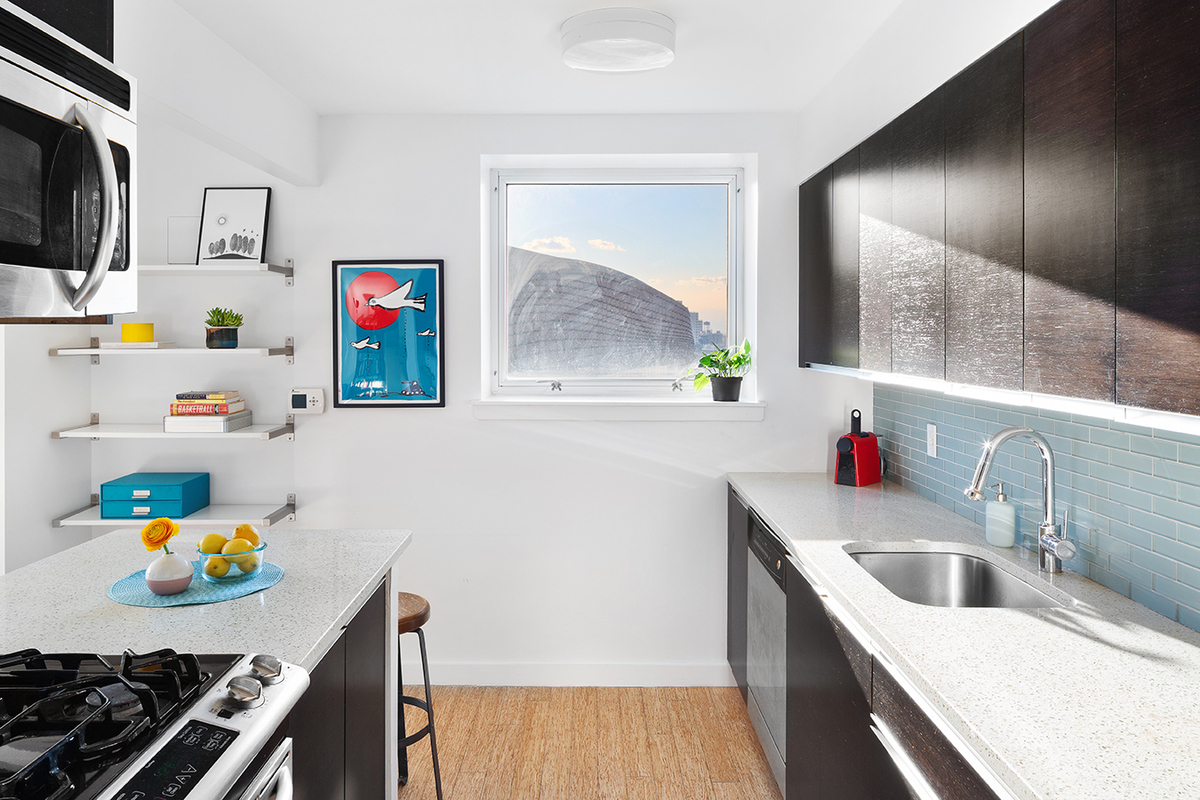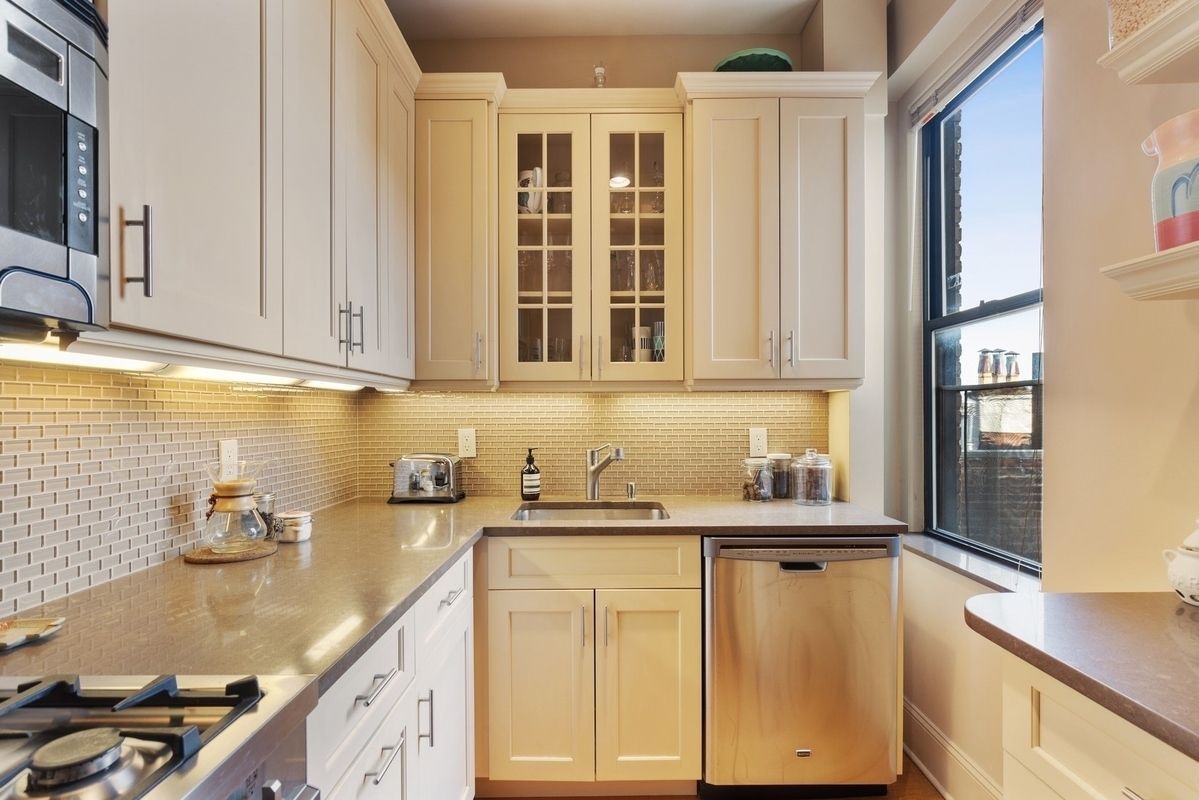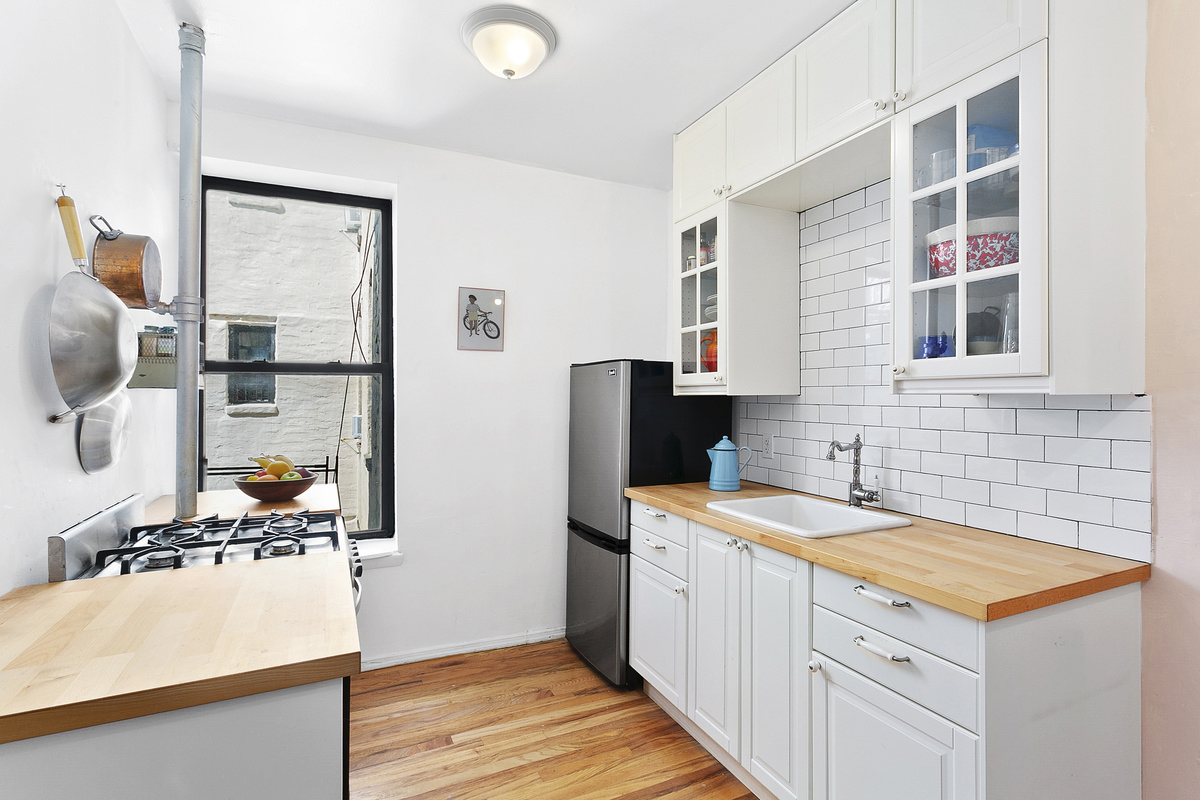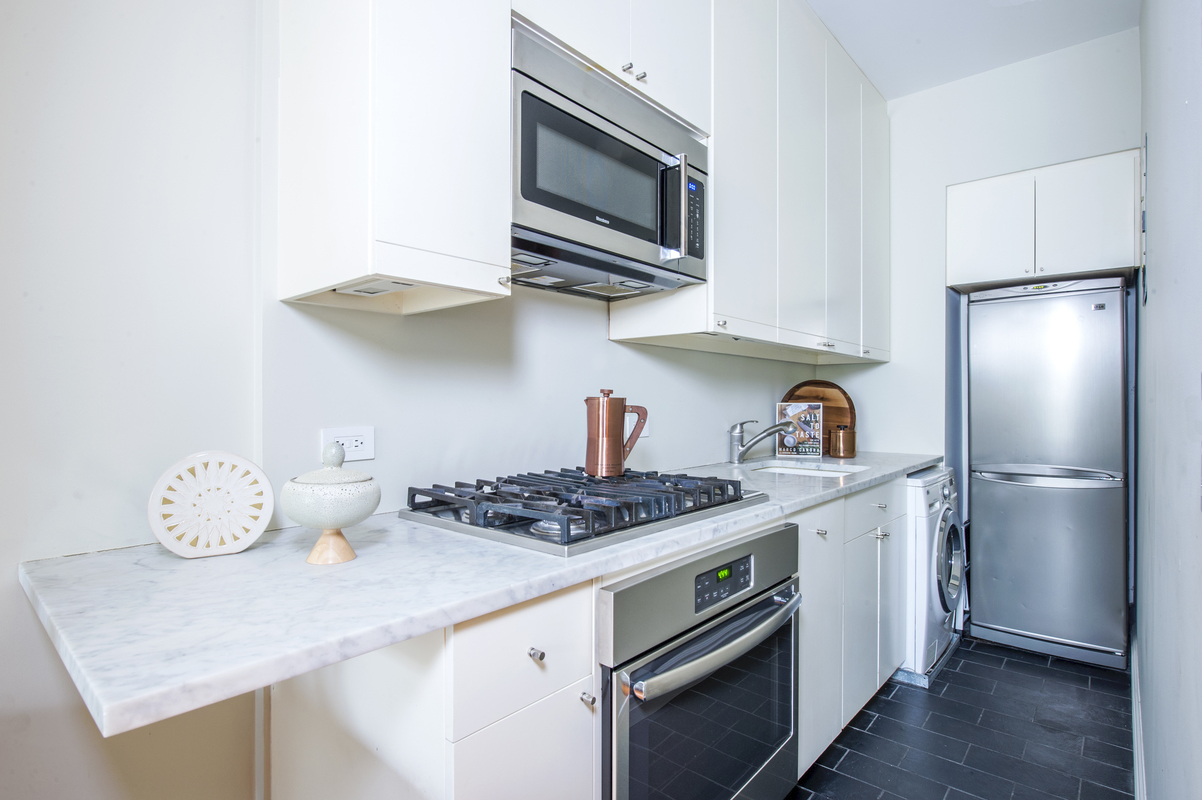COVID-19 + NYC Real Estate

A kitchen like this one in Brooklyn is considered spacious by NYC standards. Here’s how to make the most of it.
New Yorkers are used to living in fun-size spaces, but with the stay-at-home order in place, things might be feeling a little more cramped than usual. That’s especially true if you have a typically small NYC kitchen that you’re now forced to cook in for every meal. And since residents will probably be in this situation for a while longer, it’s a good idea to know how to make the most of your minuscule eatery.
Here, a professional organizer, a nutritionist, and a chef give StreetEasy their top tips on how to stock a tiny cooking space for maximally delicious meals with minimal clutter.
Essential Cookware for Small NYC Kitchens

Equipping a kitchen with just the bare essentials keeps things neat and tidy. (From a listing at 2 Grace Court #6B.)
Sure, we all want to spend this quarantine time becoming the next Martha Stewart. But it always seems like you need the most obscure kitchen tools (we’re looking at you, tofu press and garlic rocker) to make that happen.
“I discourage my clients from keeping items that have only one use, such as bread makers, juicers, and rice cookers,” says Sharon Lowenheim, a certified professional organizer and founder of NYC-based Organizing Goddess. “They take up a lot of space. When you have a small kitchen, it’s better to keep only items that have a variety of different uses.”
So, what are the absolute essentials to have to prep a multitude of delicious dishes?
- Nonstick frying pan and silicone turner: “So you can cook up eggs, veggies, fish, and more,” says Amy Gorin, MS, RDN, a plant-forward registered dietitian nutritionist in the New York City area.
- Pasta pot and strainer: “These tools allow you to whip up pasta or beans for a quick meal,” says Gorin.
- Wooden spoon: “A wooden spoon won’t scratch up a pan the way a metal one will,” she says. “I like to use wooden spoons to stir anything from pasta to stir-fries.”
- Nonstick baking tray: “You can use it to do so many things, from baking cookies to roasting veggies,” Gorin says.
- Casserole dish: “I use my casserole dishes to make everything from a bean dish to a gluten-free egg casserole to a berry crumble,” she says.
- Baking supplies: Just the basics. “A mixing bowl, measuring cups and spoons, and a spatula let you whip up anything — cookies, avocado-chocolate brownies, almond-butter protein balls,” Gorin says.
Pro organizational tip when you’re purchasing kitchen items: “Cookware is often sold in sets, but you don’t necessarily need multiple sizes of frying pans or pots,” says Lowenheim. “Pay attention to what you use most often, and donate the ones that rarely get used.”
NYC 1BRs Under $3,000 on StreetEasy Article continues below
How to Make More Space in Your Kitchen Cabinets

Organizing a small kitchen without many cabinets is possible. (From a listing at 330 S. 3rd St. #21.)
Now that you know what you need, it’s time to figure out where to put it all. That can be difficult in a small NYC kitchen with limited storage and counter space. But by following a few basic home-organizing principles, you can find room for everything and make it efficient.
“Store things where you use them,” advises Lowenheim. “Theoretically, everything you use in your kitchen should be stored there, if your space allows it.” Some rules of thumb can help indicate how accessible different items should be.
- Items used frequently: If you use something at least a few times a week, store it in an easy-to-reach location. “Your everyday dishes and cups should be in eye-level cabinets,” says Lowenheim. “Your everyday silverware and utensils should be in the handiest drawer.”
- Items used less frequently: “These should be kept in the less-accessible locations of your kitchen, such as the top cabinet — that one you need a step stool to get to — or the back of a deep cabinet,” she says.
- Items used once a year: “Things such as Christmas dishes or the Passover seder plate can be stored outside of the kitchen if you don’t have enough room for them there,” she says.
As far as what should be out on the countertop, keep it minimal. “You can save space by hanging your most frequently used pots and pans from the ceiling or on the walls,” says Lowenheim. “And you can do the same with your cooking utensils.” Things like a container holding wooden spoons, a ladle, a spatula, etc., can be out, but everything else should get put away.
Gorin also recommends having a lazy Susan in the spice cabinet and lots of baskets in the pantry. “I use the baskets for organizing everything from little bottles of jams to bars and nuts,” she says.
What to Keep in a Smaller-Than-Standard Refrigerator

Pint-size cooking spaces typically have small refrigerators similar to this one — or even smaller. (From a listing at 622 West End Avenue #4W.)
With so many takeout and dining-out options in NYC, many New Yorkers have pretty bare refrigerators most of the time. But that’s probably not the case now, when we’re all quarantined and staying inside. So, what foods should you make room for in your small NYC kitchen to avoid frequent trips to the grocery store?
“Always have the basics to be able to whip up a well-balanced meal,” says Gorin. “Lean proteins, veggies, fruit, whole grains, and healthy fats.”
- Protein essentials: “For proteins, I like to have eggs, tofu, and fish on hand,” Gorin says.
- Produce essentials: “I’ve been stocking my fridge with produce that lasts longer, such as apples, onions, and potatoes,” she says.
- Grain essentials: “Whole grains like brown rice, quinoa, and oats can be stored in the pantry,” she adds.
- Healthy-fats essentials: “Nuts, seeds, and oils can also be kept in the pantry for a while,” says Gorin.
- Baking essentials: “Obviously, if you like to bake, you’ll need basics like flour, eggs, and milk on hand,” she says.
It’s great to be fully stocked — but you don’t want to overdo it. Lowenheim shares her top tips for not overstuffing your fridge.
- Buy smaller sizes: “For example, you may not have room for a two-liter bottle of soda, but the equivalent amount in cans can be easily tucked away into the unused corners of your fridge,” Lowenheim says.
- Manage duplicates carefully: “If you’re almost out of ketchup and you’ve already bought a new one, it doesn’t have to go into the fridge until the old one is complete,” she says.
- Refrigerate only necessary items: “You don’t need to refrigerate an entire six-pack all at once if you don’t have the space,” she says. “Maybe just a few cans at a time.”
- Transfer open items into clear plastic containers: “If something’s original packaging takes up too much room, put the food into a clear plastic container,” she suggests. “And transfer leftovers into smaller containers as you use them up. Keep in mind that rectangular containers are more space-efficient than round ones.”
- Rotate your items: “Things tend to get forgotten if they are in the back of the fridge,” she says. “Be sure to rotate your items so that things get used up, rather than going bad or getting too old. The most efficient use of your fridge is to keep everything circulating.”
NYC 1BRs Under $700,000 on StreetEasy Article continues below
The Spices Every Small NYC Kitchen Needs
You can’t dine out at one of New York’s many delicious restaurant options right now. But that doesn’t mean you can’t make delectable meals at home, even with minimal provisions. The secret? Spices. Gorin advises the following spices to help make your basic provisions taste like you’re having a variety of dishes.
- Black pepper and sea salt (freshly ground): “I add these to savory dishes, such as scrambled eggs and pasta,” Gorin says.
- Nutmeg and cinnamon: “These are great to add to foods like oatmeal or Greek yogurt,” she says. “Ginger also works well in a Greek yogurt parfait.”
- Oregano, basil, and rosemary: “I like to add these to Italian-inspired dishes,” she says. They taste great in pasta, and on top of pizza.”
- Garlic and onion powder: “I often cook with fresh garlic and onions, but the powders are terrific for when I don’t have the real thing on hand,” Gorin says. “Add them to sautéed vegetables, stir-fries, and more.”
- Paprika: “I love adding smoked paprika to mac and cheese or hard-boiled eggs,” she says.
- Everything-bagel seasoning mix: “This is another go-to. I often use it on top of eggs,” she says.
- Crushed red pepper: “If you’re like me and like a bit of spice, this is a good one to add to to pasta, a rice dish, or homemade pizza,” she says.
The best part about spices is they stay fresh for a long time, says Brad Barnes, a certified master chef and director of CIA Consulting & Industry Programs at the Culinary Institute of America. “Spices can be kept for up four months if tightly sealed,” he says. “And they can keep even longer if frozen.”
—
Inspired to find your next place in New York? Whether you’re looking to rent or to buy, search NYC apartments on StreetEasy.


































